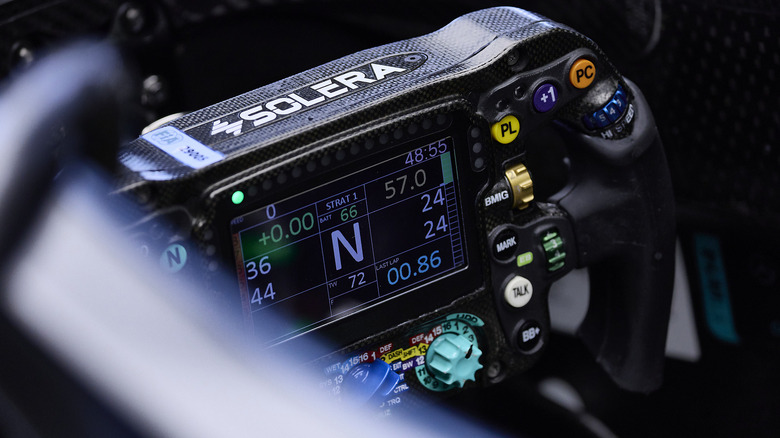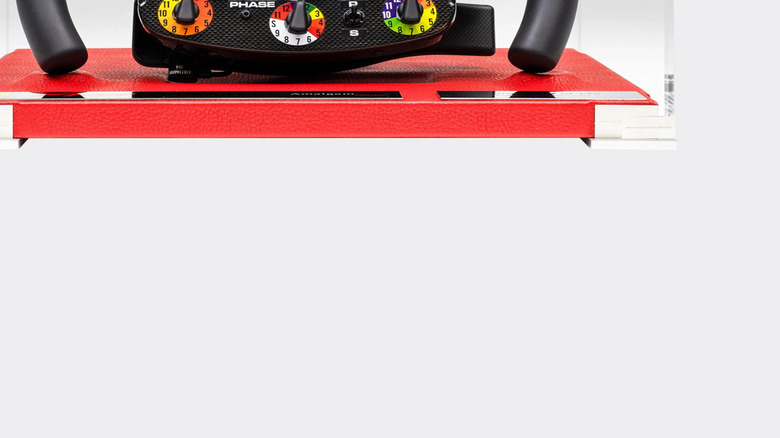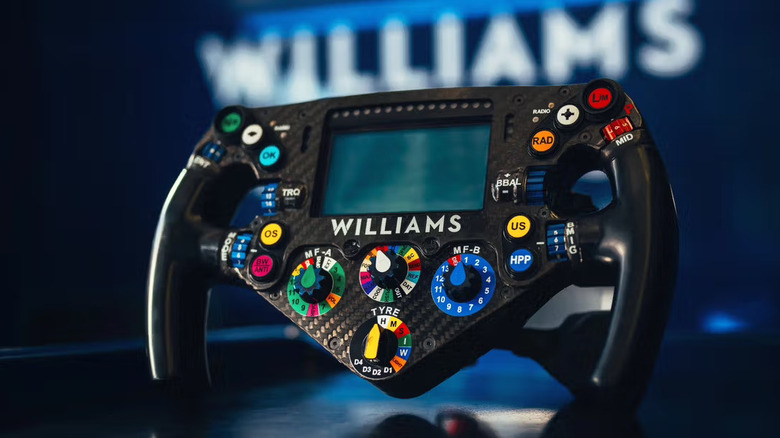What Are The Buttons On F1 Steering Wheels For?
Formula One is a sport riding on the bleeding-edge of automotive technology, with ongoing innovations across the entire developmental spectrum. These include advanced engines for improved power and fuel efficiency, aerodynamics allowing for more than five G's of turning force, and specialized safety devices like the bar in front of the driver, also known as the Halo.
These factors all contribute towards making Formula One the fastest form of circuit racing in the world. But no matter how much technology these vehicles incorporate, a driver must be able to control both the car and its many functions in a split-second. Enter the multi-function steering wheel, a deceptively complicated gadget used to control everything from brake balance to the radio, and steering the car, naturally.
Unlike the classic round wheels of yesteryear, modern Formula One steering wheels look insanely complicated and cluttered at first glance, featuring over a dozen buttons, a prominent screen, and several paddles. But, each of these elements perform an essential function of the car, and are prominently labeled and ergonomically laid out so a driver can actuate them through muscle memory with just their thumbs when racing at speed.
The buttons themselves perform various functions, as denoted by each one's label, including but not limited to: Pit lane speed, DRS, radio controls, neutral gear, drink, race start, and a notification mark for telemetry data. Not all buttons get used in the same way, either. For instance, some teams use the Accept/Cancel buttons as basic yes/no signals. Let's dive in and further explore the nerve center of a Formula One car.
Technical breakdown of commonly-found buttons
To better illustrate each button's function in real-world racing, we'll drive a theoretical session. To begin, the "N" button engages neutral gear, then the "PL" button toggles the car's pit speed limiter. As the car heads out to practice, the driver can make notations of various events and issues using the MARK button, which places a notification in the car's telemetry. For example, if the driver experienced issues with acceleration, this button indicates on the telemetry graph where and when the issue occurred. In order to communicate, the driver uses the TALK button, which activates the microphone.
Moving on to race day, the first new button is Race Start. This button acts as a speed limiter to provide a good launch, similar to launch control. Throughout the race, a driver will engage the DRS button in specific situations. DRS means Drag Reduction System, and moves the rear wing's middle flap horizontally to decrease drag for higher top speeds. Similarly, OT, or Overtake, provides a temporary engine boost, useful for overtaking.
Because racing is exhausting, hydration is mandatory for all drivers, so there's a corresponding DRINK button that pumps a fluid, usually comprised of mostly water, into the driver's mouth via tube. The driver may alter their brake balance using the corresponding BB – and + buttons. Drivers use other buttons if something goes wrong, such as PC, meaning Pit Confirm, telling the pit crew to prepare for an unscheduled stop. And the +1 / +10 buttons highlight specific functions of the car numerically, so if something's wrong with a specific sensor, for instance, the pit crew may call it out and the driver can swap to that number.
Button strategy
Every team features their own wheel pattern, with many utilizing variations of labels, additional buttons, and so on. For example, BB + and – may become BB F and R, indicating front and rear. Invariably, though, all button layouts are colored and within reach of the driver's thumbs, which is crucial in racing.
Pretend that you're racing on a particularly curvy circuit, and to gain the most speed for the next corner, you want to adjust your car's brake balance. Instead of using a rotary dial attached to the wheel, which requires the driver to one-hand drive and manipulate a setting in the middle, possibly mid-corner, instead they can flick their thumb and change it instantly.
This eliminates a dial's orientation being disrupted by the wheel rotation, and the driver maintains their hand position. Frequently used settings such as differential and brake adjustments often utilize dedicated scroll wheels located on the wheel stalks, or are prominent, brightly-colored buttons. Alongside these, drivers also control rotary dials for settings such as strategy (STRAT), engine management (ENGINE), and MGU hybrid settings, among others. Replica wheels like the Thrustmaster F1 Ferrari Wheel accurately reproduce most of these functions for sim racing.
Everyone holds their individual strategies and trade secrets close to their chest, using radio codes and unique inputs with the wheel's buttons to communicate with their respective crewmates. This ensures that one team can't watch the live feed and telemetry data of someone else's car, something commonly seen today to maximize tactical decisions, to know their opponents' strategy.


